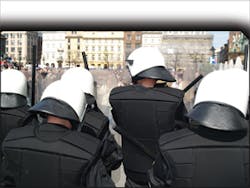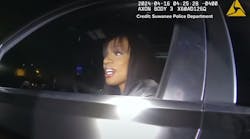This year marked the 40th anniversary of the "Summer of '69." News media happily revived images of moon-walkers, music festivals … and some serious rioting. In that chunk of years, for the first time in a while, civilians and law enforcement alike learned over and over again what a crowd can do.
But a lot has changed since then, at least in terms of containing the exuberant masses. Capt. Dennis Kato, commander of the Metropolitan division of the Los Angeles Police Department, says "Crowd and riot control is evolving as we speak." Today, agencies that train for and practice crowd control are not only updating their arsenal in surprising ways, but they are constantly tweaking their tactics to "fit the mood of the mob."
Kato's team has recently geared up for the Proposition 8 demonstrations, which drew large numbers to LA's City Civic Center in November of last year. Immigration rallies have also picked up more heat, mostly in California, but certainly in a number of cities throughout the states. In scenarios like this, Kato knows having carefully crafted products and strong tactics not only help sidestep the occasional legal tangle, but help keep officers safe, too.
"We always have [crowd and riot gear] in our arsenal," says Kato. "We have numerous events that start as crowd control issues that could easily turn into crowd control [missions]." The Metropolitan division is a specialized division of LAPD that includes K-9, mounted units and SWAT. Metro's primary responsibility is to support the department by providing additional crime suppression resources throughout the city. They respond to everything from high-risk barricaded situations to stakeouts, security details and more.
The Metro unit is dependent on three types of less-lethal munitions to manage a crowd: The first is a super sock beanbag that's shot out of a 12-gauge shotgun. It has a direct impact, and is used only on aggressive-combative individuals. In addition, officers are equipped with a 40mm exact impact sponge projectile. This basically "shoots out what looks like a racquetball round," says Kato. "It's another direct impact weapon that's fired at combative people in the crowd." The third less-lethal weapon officers carry is a 37mm foam rubber multiple baton round. The rubber pellets are skip-fired off the ground to disperse crowds that are unresponsive to commands.
When faced with huge numbers, Metro officers are equipped with 36-inch batons (longer than those used on the patrol force), which are meant to offer more space and allow them to cover more ground during riotous situations. They've also recently gone to 40mm foam baton rounds that contain dye marker packs (similar to when a bank explodes dye money packs). These packs, after having exploded on a target, can easily help officers identify instigators later on.
Surprisingly, two products absent from LAPD's riot roster are shields and tear gas. The Metro unit does not use shields. "We tried using them, but we found that they actually invite people to throw things at you," says Kato. "We bought some, we tried them and we don't deploy them. It also restricts officers because one arm is now caught holding the shield."
And to his knowledge, Kato says they have not deployed tear gas in more than 22 years. Deploying gas in LAPD requires a commander's approval — or higher. "The sheriffs in the same jurisdiction deploy the gas readily — that's their first tool," says Kato. "It's an interesting concept, but it goes back to several lawsuits and agreements that have gone on because of past incidents."
What drives a crowd?
Vehicles also enter into the mix. The Metro unit, like any SWAT or tactical team, is always on the lookout for any type of vehicle that will, when used effectively, give them the tactical edge.
"Back before the '92 riots we tried a technique in which we used black and white vehicles with their lights and sirens on, and did what we would call a 'surge,' where we would speed up to the crowd, and stop, etc.," recalls Kato. "It gave a very intimidating appearance and we would use that in line — it would almost force crowds to back up. But then we struck somebody, and so that went away."
The unit no longer utilizes motorcycles, either. "We've tried them, but the motor officers get caught when the crowd surges on them." Kato says the bikes aren't nimble enough to turn around should officers need to make a quick retreat.
What does seem to work is a new vehicle, similar to a four-wheeler, which Metro has outfitted with a magnetic audio device (MAD) system. The speaker is used in conjunction with a visible sign mounted on the back.
"It's better than your normal speaker and can project sound for long distance very clearly. We can get commands out to the crowd, letting them know what we want and what we're trying to do," says Kato. He notes they are continually trying to verbalize with crowds rather than simply act and react. "We've found the majority of the people will listen and then move away, and then we're left with that small minority that does not. It makes it easier for us to deal with that smaller group if we can peel the layers away." Metro's four vehicles were recently flown to Colorado for their use during the Democratic National Convention.
But why not go bigger? Security ProUSA, a security products company that operates out of Los Angeles, Calif., offers a large riot control vehicle that features high-powered water cannons and smart, computerized controls. The canon, connected to a computerized system, controls the amount and the intensity of the water, depending if users wish to wash the crowd, warn the crowd or really hose the crowd down. The monster 6500 riot control vehicle has a Mercedes Benz chassis, but can be make to fit other models.
Though impressive, U.S. enforcement agencies in general feel the vehicles are not practical. First, they are expensive. But also, we just don't have the large, politically driven riots here that countries like Israel or Columbia see frequently — chaotic events at which rioters think nothing of launching Molotov cocktails.
Kato reports LA County did look into purchasing the European type vehicles at one time, but did not buy. He goes on to say their most effective "vehicle" in crowd and riot situations is not a vehicle at all, but LA's mounted unit:
"Horses seem to work best. That, or officers on foot, but the mounted unit is a huge tool. Crowds do not seem to want to take on a 1,200-pound animal."
The right approach
What good are exploding ink and half-ton horses in the middle of a feisty mob if officers do not know the best way, and the right time, to use them? Perhaps more important than the right tools are the right tactics.
"We're currently transitioning," says Kato. On May 1, 2007, in McArthur Park police dispersed a crowd during an immigration rally. However, as police broke up the crowd, news and camera people were getting caught. Some received baton blows and were struck by less-lethal munitions.
"Up until that time, this department's mindset was the dispersal of the crowd: Let's just get the crowd out of the area ... and all of our tools and tactics were geared toward that," recalls Kato.
"We've since changed. Now we arrest offenders and try to get our hands on the small minority of [agitators]. When you do that, the dispersal happens and also really takes the steam out of the crowd.
After MacArthur Park, Metro set out to teach the whole department its new mindset of localizing smaller groups and making "surgical" arrests that ease the strain for both police and rioters. Metro currently works with the sheriff's department, their largest sister agency, and trains smaller agencies in the LA region, as well.
"It seems we are constantly trying to tweak tactics because you get a different sense of a crowd," says Kato. "Some crowds have more people; so you don't really need to ramp it up and [use] the big tactical gear or turtle suits; it's very intimidating when you see that. I think when you do that, you actually ramp up the crowd to that same level.
"We've been trying to minimize. We put a lot of uniform presence out there, a lot of conversation, a lot of talking prior-to, and yet we have those tactical teams placed in situations and hidden from view, to deploy as necessary.
Kato was there during the '92 riots. He says the tactics they used back then worked for that occasion, but they're a little bit smarter now, and a little bit more effective.
Riot control teams are deployed to keep things from spiraling out of control. To keep people safe should an assembly turn less than peaceful. Who knows what agencies will be suiting up with and teaching their teams in the next generation of riots?



